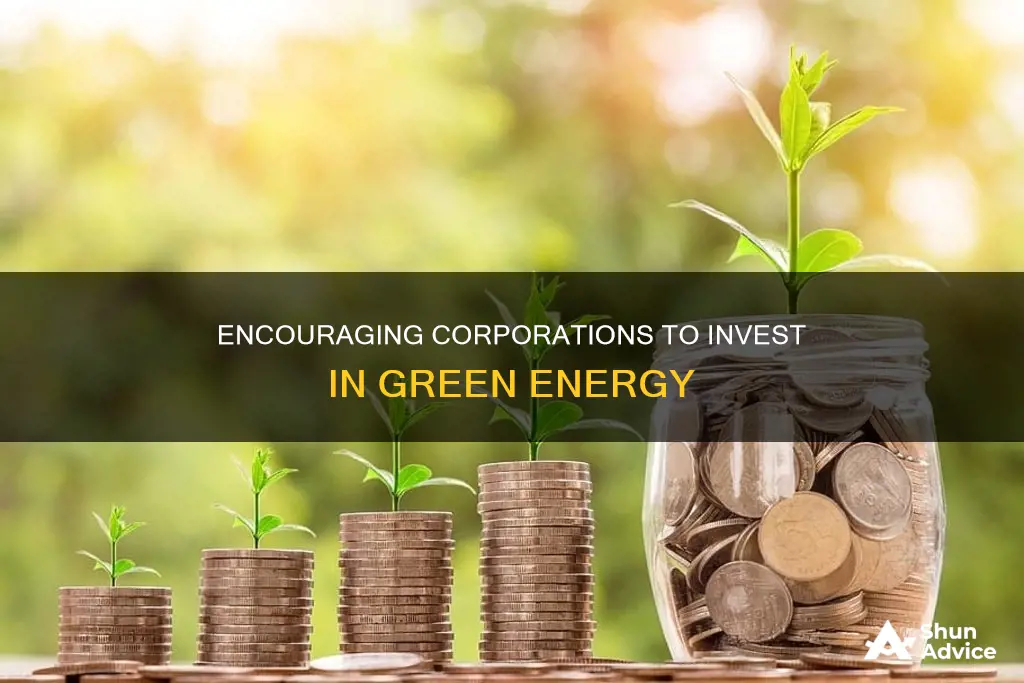
The transition to green energy is an increasingly important topic, with the world seeking to reduce its reliance on fossil fuels and move towards more sustainable sources of energy. This shift is being driven by a growing awareness of the impact of human activity on the planet, as well as the economic viability of renewable energy sources. As a result, corporations are under pressure to invest in green energy and play their part in combating climate change. This paragraph will discuss some of the ways in which corporations can be encouraged and supported to make the transition to green energy, and the benefits that this will bring.
| Characteristics | Values |
|---|---|
| Promote a faster, cheaper, and smarter renewable energy buildout | More than 290 companies have committed to sourcing 100% of their electricity consumption from renewable energy |
| Maximize the positive impact of renewable energy buying decisions | Integrate social and environmental considerations into buying decisions |
| Protect nature and carbon reserves | Commit to not buying renewable energy from projects that impact important natural areas |
What You'll Learn

Lead the market: Promote faster, cheaper, and smarter renewable energy buildout
Corporations can play a pivotal role in promoting a faster, cheaper, and smarter renewable energy buildout, which is essential to meeting the emission reduction goals outlined in the Paris Agreement. Here are some ways in which corporations can lead the market and accelerate the transition to clean energy:
Encourage faster and smarter development
Corporations can promote faster and smarter renewable energy development by making strategic purchasing decisions. By committing to sourcing 100% of their electricity consumption from renewable energy, corporations can shape how the buildout is executed. This means supporting projects that avoid impacts on wildlife habitats and conflicts with communities. For example, solar projects sited in areas of low biodiversity value have been found to have faster permitting processes (13 months instead of 35) and lower project costs. Similarly, addressing concerns related to wind siting, such as wildlife impacts and public engagement, is crucial to preventing cost increases and capacity decreases in the future.
Leverage buying power to drive down costs
Corporations can use their buying power to drive down the costs of renewable energy technologies. As prices for renewable energy continue to drop, it becomes more attractive, not just to corporations but also to low- and middle-income countries. This can lead to a significant increase in demand and accelerate the transition to clean energy.
Collaborate with initiatives and alliances
Corporations can collaborate with initiatives like the Buy Renewables Right initiative by The Nature Conservancy (TNC) and the National Audubon Society. This initiative helps companies develop clean energy buying solutions that meet goals for climate, nature, and communities. Additionally, corporations can join alliances like the Renewable Energy Buyers Alliance Institute, which offers programs such as Beyond the Megawatt to help companies integrate social and environmental considerations into their buying decisions.
Prioritize renewable energy sources
Corporations should prioritize renewable energy sources, such as wind and solar, which emit little to no greenhouse gases and are often cheaper than fossil fuels. By investing in these abundant and accessible sources of energy, corporations can contribute to reducing emissions and improving air quality, benefiting both the environment and public health.
Advocate for policy support
Corporations can also advocate for policies that support the development and adoption of renewable energy. This includes calling for an end to subsidies and tax breaks for the fossil fuel industry and instead investing in renewable energy infrastructure and technology. Additionally, corporations can support policies that promote a just transition, ensuring that the rights and needs of people are central to the energy transition.
Investment Giants: World's Largest Corporations in Investment Management
You may want to see also

Invest in solar energy
Solar energy is an increasingly popular form of power generation, and with good reason. It is efficient and environmentally friendly, and set to experience explosive growth in the coming years. As a result, investing in solar energy can be a very attractive prospect for corporations.
There are several ways in which corporations can invest in solar energy. One way is to buy stocks in publicly traded manufacturing companies such as First Solar (FSLR), SolarEdge Technologies (SEDG), and Brookfield Renewable (BAM). These companies are expected to benefit from the rapid growth of the solar industry, which will ultimately boost stock prices.
Another option is to invest in land development for utility-scale solar. This involves investing in power generation facilities that provide energy to the electric grid. These plants are becoming increasingly common in sunny states like Arizona, Nevada, and California, and they offer a range of benefits, including excellent cash returns, long-duration contracts, and low volatility due to predictable revenue.
Corporations can also participate in commercial installation tax reduction schemes. For example, the solar investment tax credit (ITC) in the US offers a 30% incentive on the cost of a solar photovoltaic (PV) system.
Solar EV charging stations are another area of interest for investors. These stations use panels to convert solar energy to power EVs, and store energy in a power bank for when the sun isn't shining. With the rise in popularity of electric vehicles, this is an area that is likely to see more investment opportunities.
Finally, corporations can consider equity investments in solar panel manufacturing. The global supply of solar panels is currently falling short of demand, and innovative solar PV panel manufacturing and assembly startup businesses require early-stage capital to get off the ground.
With the solar industry's rapid growth, investing in domestic solar manufacturing can be a solid choice for corporations, offering the potential for high returns and a great ROI.
Microservices in Investment Portfolio Management: Strategies and Benefits
You may want to see also

Invest in wind energy
Wind energy is a rapidly growing sector, with wind turbines producing about 10% of US power in 2023. As attention turns to the effects of climate change and the need to reduce dependence on fossil fuels, wind energy investments are becoming more popular.
There are two main market segments in wind energy: distributed wind and utility-scale wind. Distributed wind is made up of smaller-scale projects that generate electricity for homes, businesses, and communities. In contrast, utility-scale wind energy consists of turbines that generate more than 100 kilowatts of energy, which is then added to the electrical grid.
Ways to invest in wind energy
Wind farm operators and turbine manufacturers
Investors can put money into publicly traded companies involved in some aspect of the wind energy industry. These include wind farm operators, which own and operate wind turbines to produce energy for customers and end users, and manufacturers of turbines and other components of wind farms. Some specific companies in this category include:
- Orsted: The Denmark-based power company is the largest developer of offshore wind power globally.
- Vestas Wind Systems: The Denmark-based company is one of the world's largest manufacturers of wind turbines.
- GE Vernova: The US-based company was spun off from GE's main business in 2024 and specializes in energy equipment manufacturing.
- NextEra Energy: The American energy company has 119 wind farms in operation and is one of the world's largest wind and solar energy generators.
- Alliant Energy: The American energy company owns and operates wind farms across Wisconsin and Iowa.
Mutual funds and ETFs
Investors who don't want to pick individual stocks can consider mutual funds and exchange-traded funds (ETFs) that provide exposure to wind energy companies and investments. These funds allow investors to diversify their holdings by investing in a single security. Some examples include:
- First Trust Global Wind Energy ETF: This ETF invests in pure-play wind companies that get at least 50% of their revenue from wind-related activities, as well as diversified companies involved in the wind energy industry.
- Brookfield Renewable: A leading global clean energy infrastructure company with significant wind assets, including 11.3 GW of operating wind assets.
Benefits and risks of investing in wind energy
Benefits
- Renewable resource: Wind energy is a renewable resource that will not run out as long as the wind blows.
- Cost-effective: Wind energy tends to be one of the lowest-priced energy sources.
- Clean energy: Wind power is a clean energy source that does not produce emissions, making it attractive for investors focused on green investments.
Risks
- New technology: Wind energy is a relatively new technology, so there is limited data on its long-term performance.
- Competition from traditional energy sources: Wind energy must compete with traditional energy sources like oil, coal, and natural gas, which may impact its long-term outlook.
- Community pushback: Wind energy projects may face opposition from communities where companies want to operate.
Tips for building a wind energy portfolio
- Open a brokerage account: You will need to open an account and deposit money before you can start buying and selling stocks and other securities.
- Pick your assets: Decide what type of investment you want to make, such as a company's stock, a wind energy-focused ETF or mutual fund, or bonds.
- Do your research: Research different companies and funds to find a diversified selection that fits your investment goals and priorities.
- Monitor your portfolio: Once you've made your investment, keep an eye on your portfolio to ensure that your assets have a positive social and financial impact.
- Diversify: Remember to diversify your portfolio by investing in various asset classes to reduce risk and maximize returns.
A Beginner's Guide to Investing in MCX India
You may want to see also

Invest in hydroelectric power
Hydroelectric power, or hydropower, is electricity generated by the flow of water. Water flowing through a turbine spins the turbine, generating electricity. This process can be traced back hundreds of years to when flowing water was used to turn a wheel for grinding wheat into flour.
Hydropower is a significant contributor to the renewable energy mix, accounting for 31.5% of total utility-scale renewable electricity generation in the US and 16% globally.
If corporations are looking to invest in green energy, here are some reasons why they should consider hydroelectric power:
Reliable and Flexible Energy Source
Hydropower has long been a reliable source of energy and storage, providing 96% of the US's utility-scale energy storage capacity. As more variable renewables like solar and wind connect to the grid, hydropower can balance supply and demand as a firm, flexible, and renewable power source.
Untapped Investment Opportunities
Hydropower investment opportunities remain untapped, especially for small- and medium-sized projects. Less than 3% of the over 90,000 dams in the US produce power, leaving thousands of non-powered dams with potential for development. Additionally, existing dams can be updated to increase capacity, and millions of miles of waterways can be utilised for in-stream hydropower.
Attractive Financial Prospects
With the Bipartisan Infrastructure Law and the Inflation Reduction Act, new hydropower projects can benefit from various financial support options. As the world transitions from fossil fuels to low-carbon energy sources, hydropower's value as a reliable and flexible power source will only increase.
Technological Innovations
Hydropower innovations are moving towards smaller, more modular, and flexible solutions. For example, modular conduit hydropower systems can be manufactured off-site, reducing construction costs and timelines and increasing flexibility in system expansion.
Public-Private Partnerships
Public-private partnerships are crucial for successful hydropower projects. While government support is often necessary, private capital is also essential. Organisations like the International Finance Corporation (IFC) have programmes that provide upfront equity and actively assist in project development, helping to address market failures and attract private investment.
Regional Considerations
When considering investment in hydroelectric power, it is essential to evaluate the potential of different regions. For example, the Pacific Northwest in the US has more rainfall than most other continental areas, and the snowmelt in the mountains feeds into rivers and tributaries, providing ideal conditions for hydropower plants.
In conclusion, investing in hydroelectric power offers corporations an opportunity to support renewable energy while also benefiting from the reliability, flexibility, and financial attractiveness of this energy source. With untapped potential, especially in small- and medium-sized projects, corporations can play a vital role in harnessing the power of water to meet the world's growing energy demands.
Understanding Cash in Your Investment Portfolio
You may want to see also

Invest in green infrastructure
Investing in green infrastructure is a crucial aspect of corporate involvement in the transition to clean energy. Here are some ways in which corporations can invest in green infrastructure:
Lead the Market:
Corporations can promote a faster, cheaper, and smarter renewable energy buildout. They can commit to sourcing 100% of their electricity consumption from renewable energy, joining the ranks of over 290 companies that have already made this pledge. In 2020, corporations globally purchased a record 23.7 GW of clean energy, which is about 10% of the world's total renewable energy investments. By making ambitious clean energy commitments, businesses can shape the market and accelerate the shift towards renewable energy sources.
Buy the Best:
Not all clean energy projects are created equal. Corporations should aim to maximize the positive impact of their renewable energy buying decisions. Some projects may displace more fossil fuel emissions, while others might have greater impacts on wildlife habitats or provide more benefits for local communities. By integrating social and environmental considerations into their procurement strategies, companies can ensure their investments have a positive impact on climate, nature, and communities.
Protect Nature and Carbon Reserves:
It is essential to promote a buildout that avoids biodiversity impacts and carbon storage losses. While the development of wind and solar energy projects can lead to habitat loss and wildlife collisions, there are abundant low-impact lands with high renewable energy development potential. Corporations can advance their climate goals while also conserving nature by committing to not buying renewable energy from projects that harm natural areas.
Invest in Sustainable Infrastructure:
Corporations can connect with investors seeking stable returns and long-term renewable energy projects. This involves partnering with independent power producers and investment managers to bring clean power opportunities to market, enabling individual investors to participate in the energy transition.
Focus on Water Investments:
Water is a crucial natural resource, and there are growing concerns about water scarcity due to climate change. Corporations can invest in companies that collect, purify, and distribute water, such as American Water (AWK) and Essential Utilities (WTRG). Additionally, mutual funds like the Calvert Global Water Fund and Virtus AllianzGI Water Fund offer opportunities to tap into water-based investments globally.
By implementing these strategies, corporations can play a pivotal role in driving the transition to clean and green energy while also creating sustainable value for their organizations and contributing to the betterment of the planet.
National Savings, Investment, and Their Symbiotic Relationship
You may want to see also
Frequently asked questions
Renewable energy sources such as wind, solar, and hydroelectric power supply more than 20% of the electricity generated by the U.S. power sector. The industry has been growing rapidly, with solar generation capacity expected to grow by at least 325% from 2022 to 2050. This growth is driven by economic viability and government support, making it an attractive investment opportunity.
Corporations can invest in green energy by committing to sourcing 100% of their electricity consumption from renewable sources. They can also invest directly in renewable energy development projects or buy renewable energy from specific projects that align with their values and have a positive impact on climate, nature, and communities.
Some of the biggest renewable energy companies include NextEra Energy, Brookfield Renewable, First Solar, and Constellation Energy. These companies have a strong track record of creating shareholder value and investing in renewable energy sources.
One challenge is the large amount of land required for renewable energy infrastructure, particularly for onshore wind and utility-scale solar installations. This can lead to conflicts with local communities and natural habitats. Additionally, some renewable energy projects may have greater impacts on wildlife and habitat loss. It is important for corporations to make informed decisions when investing in renewable energy projects to minimize these potential negative consequences.







